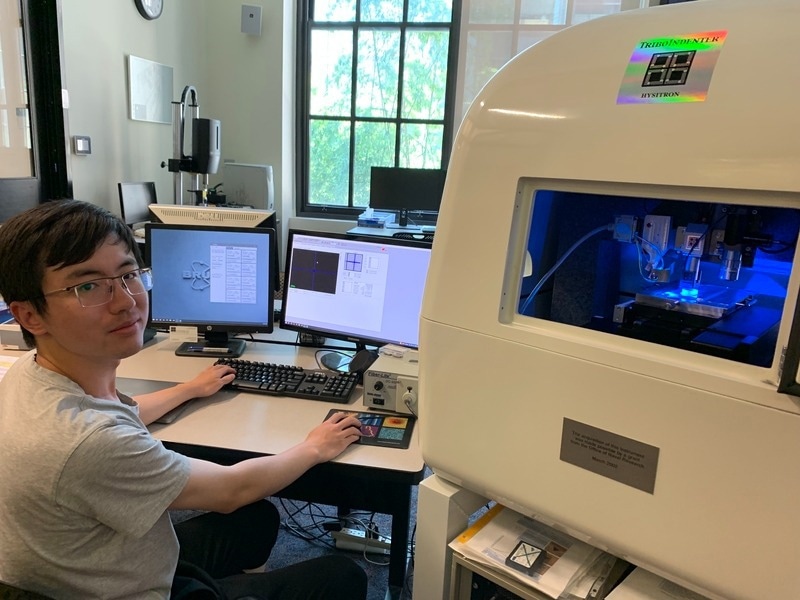MIT engineers reveal a novel discovery in semiconductors, well-known materials that have been the subject of intensive study for over 100 years due to their numerous applications in electronic devices.
 MIT graduate student Jiahao Dong with the nanoindentation machine used in recent MIT work on the response of semiconductors to light. Image Credit: Elizabeth Thomson/Materials Research Laboratory
MIT graduate student Jiahao Dong with the nanoindentation machine used in recent MIT work on the response of semiconductors to light. Image Credit: Elizabeth Thomson/Materials Research Laboratory
The scientists discovered that these significant materials respond to light by becoming significantly stiffer and that this impact is reversible when the light is switched off.
The engineers also describe what is occurring at the atomic level and demonstrate how the impact can be altered by introducing particular flaws into the materials and utilizing various light colors and intensities.
We’re excited about these results because we’ve uncovered a new scientific direction in an otherwise very well-trod field. In addition, we found that the phenomenon may be present in many other compounds.
Rafael Jaramillo, Study Team Leader and Thomas Lord Associate Professor, Materials Science and Engineering, Massachusetts Institute of Technology
Ju Li, another MIT professor involved in the work, says, “To see defects having such big effects on elastic response is very surprising, which opens the door to a variety of applications. Computation could help us screen many more such materials.”
Li holds a combined appointment in the Department of Materials Science and Engineering (DMSE) and is the Battelle Energy Alliance Professor of Nuclear Science and Engineering (NSE). Li and Jaramillo are also connected to the Materials Research Laboratory.
The work was published in the August 3rd issue of Physical Review Letters. Jiahao Dong and Yifei Li, both graduate students in DMSE, contributed to the work.
Alan Schwartzman, a research scientist in DMSE, Yuying Zhou, a visiting graduate student from the Shanghai Institute of Applied Physics, Haowei Xu, a graduate student in NSE, and Bilal Azhar, a DMSE undergraduate who will graduate in 2020, are authors on the paper.
Intriguing Problem
A 2018 Science publication describing how a semiconductor constructed of zinc sulfide grows more brittle when exposed to light caught Jaramillo’s attention.
“When [the researchers] shone a light on it, it behaved like a cracker. It snapped. When they turned off the light, it behaved more like a gummy bear, where it could be squeezed without breaking into pieces,” he said.
Throughout the process, the scientists demonstrated that the semiconductors changed their elasticity, a type of mechanical stiffness when exposed to light.
“Think of a bouncy ball. The reason it bounces is that it is elastic. When you throw it on the ground, it deforms but then immediately springs back (that is why it bounces). What we discovered, which was quite surprising, is that the elastic properties [of semiconductors] can undergo tremendous changes under illumination and that these changes are reversible when the light is switched off,” says Jaramillo.
The scientists used a delicate method known as nanoindentation in the current work to conduct several experiments with zinc sulfide and two other semiconductors to determine the stiffness of the materials under various situations, such as light intensity.
This method measures the force required to push a pin through the top 100 nanometers, or billionths of a meter, of the surface by moving a diamond tip across the material’s surface.
Additionally, they ran computer simulations of potential atomic-scale events to gradually formulate a theory of what was occurring. They found that the materials’ mechanical response to light was significantly influenced by defects, or missing atoms, in the materials.
These vacancies cause the crystal lattice of the material to soften because some of the atoms are farther apart. Think of people in a subway car. It’s easier to squeeze in more people if there are bigger spaces between them.
Rafael Jaramillo, Study Team Leader and Thomas Lord Associate Professor, Materials Science and Engineering, Massachusetts Institute of Technology
“Under illumination, the atoms present are excited and become more repellent. It’s as if those people in the subway car suddenly started dancing and throwing their arms around,” he continued. As a result, the material becomes more mechanically stiff and the atoms more firmly resist being packed closer together.
The scientists rapidly realized that they could adjust that stiffness by varying the light’s color and intensity as well as by intentionally designing particular flaws into the materials.
It’s nice when you can reduce something to defect engineering because then you can plug into one of materials scientists’ core competencies, which is controlling the defects. That’s pretty much what we do for a living.
Rafael Jaramillo, Study Team Leader and Thomas Lord Associate Professor, Materials Science and Engineering, Massachusetts Institute of Technology
The Office of Naval Research provided funding for this project.
Journal Reference
Dong, J., et al. (2022) Giant and Controllable Photoplasticity and Photoelasticity in Compound Semiconductors. Physical Review Letters. doi.org/10.1103/PhysRevLett.129.065501